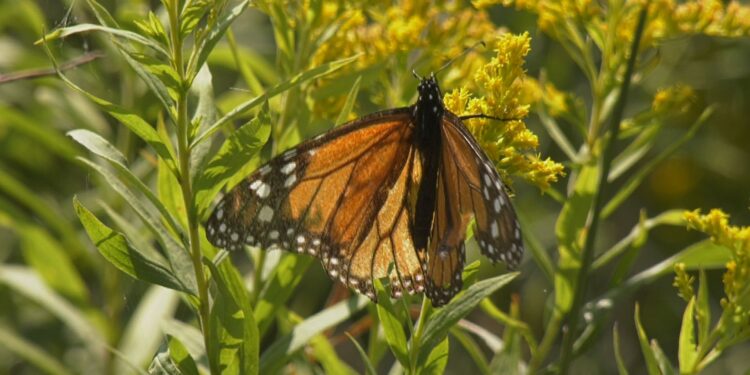STONINGTON PENINSULA, Mich. (WZMQ) – For the next few weeks, sharp-eyed visitors of the Peninsula Point Lighthouse may spot monarch butterflies.
The butterflies have been the focus of tourism and research since 1994.
“The Forest Service was receiving calls from people in the fall wondering why there were so many monarchs down here at Peninsula Point,” said Susan Jamison, Monarch Project volunteer. “No one really knew the answer to that question.”
Wildlife Unlimited of Delta County funded a study, which found that the monarchs migrate to Mexico. The migration funnels to Peninsula Point from across the U.P. and Canada.
“Monarchs do not like to fly over water, and so the end of our peninsula over to Door County, Wisconsin is a short distance for them to fly,” Jamison explained.
Monarchs only fly during the day. At night, they roost in cedar trees.
“The cedar trees often protect them from the weather,” said Jamison. “They will cluster together and form a micro-climate with each other so it prevents them from getting too cold or too hot.”
Earlier in the summer, monarchs lay hundreds of eggs on milkweed. Jamison says milkweed is the only plant their larvae will eat.
The late-summer monarchs now at Peninsula Point live for eight to nine months. They will soon begin their trip down south.
“Probably would take them a couple months to get to their winter habitat in Mexico,” Jamison said. “The females will start laying eggs. Those eggs will go through the larva stages, the chrysalis stage, and emerge as adult butterflies so that they will continue the journey north.”
The Monarch Project tags as many monarchs as possible each year to learn more about their migration. According to Jamison, Peninsula Point now has one of the oldest sets of data on monarch butterflies in North America.
“Each tag has a number on it and that number is recorded,” she said. “The data is sent to the University of Kansas, where the tagging center is.”
Two nearby fields are filled with milkweed plants. Once a week throughout the summer, volunteers check the plants for eggs and larvae. That information is sent to the Monarch Larva Monitoring Project at the University of Minnesota.
“We have volunteers who are passionate about monarch butterflies and want our data here to be consistent,” Jamison said.
The Forest Service has recorded anywhere from several hundred to 4,000 monarchs roosting at Peninsula Point in a given year. Even on days when only a few are flying around, Peninsula Point becomes a popular tourist stop.
“People will be down here at 7 or 8 o’clock in the morning watching them roost on the trees,” said Jamison. “It’s an exciting sight, and I think one that you never tire of.”
Depending on weather conditions, Jamison expects monarchs to be found at Peninsula Point through the third week of September.


















